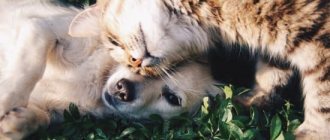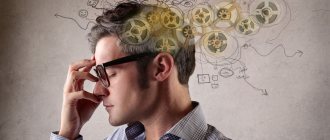The relationship between phenotype and genotype
The genotype of an organism determines its phenotype.
All living organisms have DNA, which provides instructions for the production of molecules, cells, tissues and organs. DNA contains the genetic code, which is also responsible for directing all cellular functions, including mitosis, DNA replication, protein synthesis, and molecular transport. An organism's phenotype (physical traits and behavior) is determined by its inherited genes. Genes are specific sections of DNA that encode the structure of proteins and determine various characteristics. Each gene is located on a chromosome and can exist in more than one form. These different forms are called alleles, which are located in specific locations on specific chromosomes. Alleles are passed from parents to offspring through sexual reproduction.
Diploid organisms inherit two alleles for each gene; one allele from each parent. The interactions between alleles determine the phenotype of an organism. If an organism inherits two identical alleles for a particular trait, it is homozygous for that trait. Homozygous individuals express one phenotype for a given trait. If an organism inherits two different alleles for a particular trait, it is heterozygous for that trait. Heterozygous individuals can express more than one phenotype for a given trait.
Complete, incomplete and co-dominance
Traits can be dominant or recessive. In complete dominance inheritance patterns, the phenotype of the dominant trait completely masks the phenotype of the recessive trait. There are also cases where the relationship between different alleles does not show complete dominance. In incomplete dominance, the dominant allele does not completely mask the other allele. This results in a phenotype that is a mixture of the phenotypes observed in both alleles. With codominance, both alleles are fully expressed. This results in a phenotype in which both traits are observed independently of each other.
| Type of dominance | Trait | Alleles | Genotype | Phenotype |
| Complete Domination | Color | R-red, r-white | Rr | Red color |
| Incomplete dominance | Color | R-red, r-white | Rr | pink color |
| Codominance | Color | R-red, r-white | Rr | red and white color |
How can environment interact with genotype during development?
It is clear that the result of development - the phenotype - depends on the joint action of genes and the environment. Genes and traits are linked through a complex network of developmental pathways. All individual differences that differential psychologists and psychogeneticists are concerned with are the result of the developmental circumstances of specific individuals in specific environments. Often individuals brought up in apparently different environments have much in common. Conversely, siblings raised in the same family, seemingly under similar circumstances, due to subtle differences in the conditions of upbringing and development, will actually experience very different influences from both the physical and social environment.
Thus, the process of interaction with the environment is complex and ambiguous. Note also that psychologists and other researchers often use the term “interaction” in a statistical sense when examining the interaction of individual factors in the production of any measurable effect. Let us emphasize that the statistical interaction of factors and the interaction of genes and environment in individual development are completely different things. They should not be confused.
For us, the formulation is quite familiar, which states that the manifestation of a phenotype is the result of the interaction of the genotype with the environment during development. However, if you think about this statement, it does not seem so obvious. After all, interaction presupposes that its participants come into contact and come into contact. In fact, our genotype, that is, the genetic apparatus, is hidden deep inside the cell and is separated from the external environment not only by the integument of the body, but also by the cellular and nuclear membranes. How can the external environment interact with genetic structures?
It is clear that genes and the surrounding world are not in direct contact. The organism as a whole interacts with the external environment; genes interact with various biochemical substances inside the cell. But various cellular substances can be influenced by the outside world. Let's consider what is known about these processes today's science. To do this, we will again have to turn to molecular genetics and consider in more detail how genes function, since in the previous presentation we only stated that the main function of a gene is to encode the information necessary for the synthesis of a specific protein.
What is GENOTYPE and PHENOTYPE - definition in simple words.
In simple words, Genotype is internally encoded heritable information that is carried by all living things. This is a kind of master plan or set of instructions for building a new organism, which indicates all the parameters of how this organism will look and function. These instructions are transmitted in encoded form - genetic code. In turn, the genetic code is present in all cells of the body, and it is copied during cell division or reproduction, passing on hereditary information to offspring. The information contained in the genetic code is directly related to all aspects of the life of the cell and the organism as a whole. It is she who controls absolutely all processes, from the formation of protein macromolecules to the regulation of metabolism and cell regeneration.
In simple words, Phenotype is the appearance and behavior of a particular individual. In other words, it is the result of what an organism has become under the influence of the components of the genotype, the ratio of dominant alleles and the environment.
GENOTYPE and PHENOTYPE - how they differ.
Speaking of such two concepts as “genotype” and “phenotype”, first of all it should be noted that they are indeed closely related to each other, but have fundamental differences. The fact is that the term Genotype is applicable specifically to the genetic information contained in the gene code. The genotype can only be determined through biological tests and studies. In turn, the phenotype is the consequences of the genotype and other factors that can simply be seen.
If we talk about the differences quite simply, then:
- The genotype is a code (it cannot just be seen);
- Phenotype is the way the code manifests itself (you can observe: eye color, hair color, height, behavior, etc.).
In conclusion, I would like to note that in fact, the topic of genotypes, phenotypes, their characteristics and influence is a very broad topic that occupies a significant layer in biology. In this article, we only introduced you to what the definitions of genotype and phenotype are in the most accessible and understandable way.
What is genotype
This is the totality of hereditary information in the body. In other words, it is the sum of genes that forms a single system.
Unlike the gene pool, it describes not the entire species, but an individual.
How to determine genotype
To determine the genotype of animals and plants, analytical crossbreeding is used. It is based on crossing an indeterminate individual and an individual with a homozygous (identical) set of chromosomes.
Since the second individual produces one gamete of a recessive trait, identifying the first individual is easy and simple.
But a person, in order to find out his set of genes, needs to be tested in a special laboratory.
How the genotype changes
A change in the set of genes can be caused by a mutation. During this process, the structure of DNA changes, which can be inherited. Mutations occur for various reasons.
For example, due to ultraviolet rays, radiation or exposure to chemicals.
Mutations are divided into:
- genetic;
- chromosomal;
- genomic;
- somatic;
- cytoplasmic.
Gene mutations imply a change in the structure of one gene, chromosomal mutations mean a modification of the structure of a chromosome, genomic mutations mean changes in the number of chromosomes.
Mutations can also be spontaneous or artificial. The first occur spontaneously and occur throughout life. The latter are artificially caused in the laboratory.
Mutations are mostly lethal or neutral. Occasionally, mutations are beneficial to the body.
The set of genes can also change due to combinative variability. It is based on the recombination of genes during the sexual process.
As a result of what process is the genotype of the offspring formed?
It is formed as a result of the fusion of parent gametes. For example, when two homozygous organisms merge, the offspring will receive the genotype “aa”.
What is a phenotype in biology
Phenotype in biology is a set of characteristics formed on the basis of the genotype. However, under the influence of the environment, the set of properties can change, which is why individual differences appear.
Based on the properties of an organism, it is not always possible to understand what genotype an individual has. Organisms can have the same set of properties even with a different set of genes. For example, a red flower can have both AA and Aa genotypes. In this case, analytical crossing is used to determine the set of genes.
Accidents of development
The variability of developmental phenomena depends on many reasons. Heredity tends to reduce developmental variability, whereas conditions not associated with heredity tend to increase it. Some developmental researchers identify four types of random factors that influence developmental variability:
- accidents in the selection of parental pairs, the genes of which make up the genotype of the individual;
- randomness of epigenetic (that is, external to the genotype) processes within individual ontogenesis;
- the randomness of the maternal environment in which the individual develops;
- the randomness of the non-maternal environment in which the individual develops.
Although these are random events, they all have an element of heredity. The genotype is inherited from the parents, and the offspring and parents have common genes that influence the course of individual development. Epigenetic processes within the body represent the influence of other cells or their products on the activity of the genotype of a given cell. Since all cells in the body have the same genotype, it is natural that epigenetic influences are associated with heredity. However, epigenetic processes are stochastic, open to the influence of environmental factors of the organism and, therefore, to any historical accidents.
The maternal environment of mammals is a very important element of the external environment. Mothers provide the intrauterine and postnatal (baby care and education) environment for the child. It is clear that these conditions are influenced by the mother's genotype. Partially, the mother's genes are shared with the offspring, so the maternal environment can be inherited. The maternal environment is also sensitive to historical contingencies.
Nonmaternal environmental effects also influence developmental variability. This includes factors that are chosen by the individual himself or shaped by the people around him, including relatives with whom he shares genes. Therefore, these environmental effects, to some extent, are also influenced not only by random environmental events, but also by genes, and are also inherited (genotype-environmental covariation).
Thus, in accordance with the above classification, in all the described elements of the environment external to a given individual, there are mechanisms for inheritance, both genetic and non-genetic (various traditions, etc.).
Naturally, non-heritable factors also influence development. These are those features of the environment that are not associated with changes caused by the developing individual himself or his related environment. They can be either random or natural. Regular changes include cyclical changes (change of day and night, change of seasons, etc.), widespread influences (gravity) or predictable factors (temperature, pressure). Non-heritable factors are also present in the maternal and other social environment (quality of maternal nutrition, maternal stress level, number and gender of siblings, etc.). Randomly or systematically changing environmental events contribute to variability in development.
All events external to genes that take place during the process of ontogenesis, together with genetic factors, create the background against which development takes place. Due to the impact of a huge variety of regular and random events in ontogenesis, developing systems can organize and reorganize. Genes make development possible, but other components that influence the development of the system are no less important participants in the development process.
At the beginning of the presentation, defining the concept of phenotype, we emphasized that the phenotype is the result of the interaction of the genotype and the environment, however, in the light of what has been said about the process of individual development, we must make some clarification in this formulation and, along with environmental factors, mention accidents of development that cannot be reduced to purely environmental influences. If we tried to graphically depict the dependence of the phenotype on various factors, then we would need at least a four-dimensional space in which, in addition to the axes for genotype and environment, there would also have to be an axis for the accidents of development.
From a school biology course, we know that what our body should be like, all the information about us down to the smallest detail - from hair color to heart size, all this information is encoded and transmitted in our genes. The totality of all the genetic information of an organism is called the genotype. With the help of genome sequencing, it is possible to completely decipher the hereditary data of any living creature and find out what it should be like based on its genetic code.
Despite this “predestination”, all living organisms are born slightly different from each other. The same characteristics recorded in the “genetic passport” will manifest themselves differently in real life. Identical twins, varieties of peas or wheat bred by long-term selection, bacteria of the same pathogen in two separate populations will differ, sometimes quite significantly.
The way hereditary traits manifest themselves in each specific case is called the “phenotype.” This is a fairly broad concept that can include both directly observable characteristics, such as skin color or height, and characteristics that we can only identify through clinical testing, such as blood type or reaction to an allergen. Some scientists refer to the concept of phenotype as mental functions or even the results of instinctive behavior - for example, built bird nests or beaver dams.
How is it that the same genes produce different observable traits? There is a certain flexibility in our genetic mechanism, and it is thanks to this that evolution and natural selection are possible. Genes determine everything in our body, but it would be a mistake to think that they determine everything with absolute precision. A particular organism is the result of the interaction between what it has inherited and the environment in which it grew and developed. Even twins from the same egg will have different fingerprints and iris patterns.
The leaves of an arrowhead growing in a swamp will be one shape if they grow under water, and another shape if they grow above it. The Himalayan rabbit may have more or less dense fur depending on the altitude at which it lives. Pines growing on the edge of the forest grow short, with bizarrely curved trunks, while their neighbors, grown from the same seeds, but standing two hundred meters deeper in the forest, will be straight, like an arrow, and up to 50-60 in height. meters.
Moreover, not all signs and traits of a living organism are explained by the direct influence of the environment. Yes, a pine tree in the forest reaches towards the sun, so it is tall, and at the edge it is hidden from its rays - so it is spreading. But there are also more subtle mechanisms that are related to the process of “gene expression,” that is, how actively a particular gene realizes itself in the production of the proteins that it encodes.
The most striking example is the differences in phenotype in the offspring of mammals depending on when they are born - in spring or autumn. Spring offspring are usually born with a lighter coat, and winter offspring with a thicker coat. How does this happen, since embryos have no contact with the environment and know nothing about the temperature outside the mother’s body? It turns out that the number of sunny days affects the melatonin produced by the parent’s body, and it, in turn, regulates the expression of the gene responsible for the type of fur the offspring will have.
The study of phenotype is especially important when it comes to medicine, because the compatibility of the donor and recipient (blood groups, HLA compatibility), metabolism, reactions to allergens and many other properties of the body are set precisely at the phenotypic level. Close relatives can (and most likely will) have different blood groups, and the best donor for a bone marrow transplant is not a brother and sister, and certainly not parents, but a complete stranger, who, however, will match the recipient as much as possible in tissue phenotype compatibility (leukocyte antigen).
Thank you for your attention! Please give us a little more time. Blood5 is a publication of Rusfond , and together we are working to ensure that the register of bone marrow donors is replenished with new participants, and each patient with an oncohematological diagnosis has a greater chance of salvation. Join us: make a monthly donation directly on our website for any amount - 500, 1000, 2000 rubles - or make a one-time contribution to the development of the Vasya Perevoshchikov National Bone Marrow Donor Registry. Help us help. Together - we are force. Yours, Blood5.
Genotype, genome and gene pool
The term “genome” was proposed by the German biologist G. Winkler 10 years later than the concept of “genotype” was formulated.
Genome also refers to a collection of genes, but unlike a genotype, a gene is considered as a nucleotide sequence of DNA in haploid cells (with a single set of chromosomes), and not as an allele (an alternative form of the same gene) in a diploid set of chromosomes.
In order not to get lost in the jungle of genetics, it is important to understand the main thing:
The genome, being the hereditary material of an organism, is stored in several (sometimes in one) chromosomes, the number of which is unique for a particular species.
The genome size (based on the number of genes it contains) varies widely, reaching several tens of thousands of units. The fewest genomes were found in the simplest viruses (several hundred), the largest number were found in representatives of the plant world (for example, there are more than 46,000 of them in rice).
According to recent studies, the human genome consists of 46 chromosomes (23 pairs), which contain about 22-25 thousand genes.
Individuals from different populations can interbreed and produce offspring. The gene pool of a species is made up of the gene pool of populations.
The characteristic features of the gene pool include the following distinctive qualities:
- Under constant environmental conditions, the gene pool remains unchanged.
- When external conditions change, individuals whose genes possess traits useful for survival gain an advantage. It is these individuals that will pass on the most valuable qualities to their offspring during sexual reproduction.
- The genes responsible for the most “advantageous” traits accumulate from generation to generation, creating the basis for changes in the gene pool.
- The variability of the gene pool as a mechanism of natural selection is directional and helps to improve the adaptive functions of the body.
The evolutionary changes occurring in the population can be traced in the following examples. In harsh climatic conditions (extreme cold, heat), the proportion of genotypes that increase the thermal insulation of organisms increases.
In other cases, the preservation of a population largely depends on genes encoding the color of the animal (in order to improve camouflage), or the synthesis of protective enzymes (liquids, gases), or behavior patterns, etc.
All this makes the population (or species as a whole) more resistant to the external environment, and therefore ensures its survival.
It happens that some genes (in parents or their descendants) turn out to be damaged (mutated), but this has practically no effect on the genotype, since mutations caused by such genes are unstable and are almost never repeated in inheritance. It follows that the human genome is absolutely stable.
The history of these concepts
What genotype and phenotype are can be understood by learning the history of the origin of these scientific terms. At the beginning of the twentieth century, the science of the structure of a living organism and biology was actively studied. We remember Charles Darwin's theory of evolution and the emergence of man. He was the first to put forward the Temporary hypothesis about the separation of cells in the body (gemmules), from which another individual could subsequently emerge, since these are germ cells. Thus, Darwin developed the theory of pangenesis.
41 years later, in 1909, the botanist Wilhelm Johansen, based on the concept of “genetics” already known in those years (introduced in 1906), introduced a new concept into the terminology of science - “gene”. The scientist replaced with it many words that were used by his colleagues, but which did not reflect the entire essence of the innate properties of a living organism. These are words such as “determinant”, “germ”, “hereditary factor”. During the same period, Johansen introduced the concept of “phenotype,” emphasizing the hereditary factor in the previous scientific term.
Historical reference
In 1909, Wilhelm Johansen (a Danish scientist) for the first time, in combination with the concept of genotype, proposed a definition of phenotype. This made it possible to distinguish heredity from the result of its implementation. The idea of differences can also be traced back to the work of Mendel and Weissmann. Moreover, the latter distinguished between somatic and reproductive cells in multicellular organisms. The chromosome set received from the parents is contained in the cell nuclei. Chromosomes carry a set of genes characteristic of a particular species in general and a particular organism in particular. Genes contain information about proteins that can be synthesized, as well as about the mechanisms that, in fact, determine and regulate synthesis. What happens then? During ontogenesis, genes are sequentially turned on and the proteins encoded by them are synthesized. As a result, the formation and development of all the properties and characteristics of the organism that make up its phenotype occurs. In other words, a certain “product” is obtained from the implementation of the genetic program contained in the genotype.
Genotype and phenotype
- The genotype contains encoded hereditary information, represented by the genetic code, which can only be deciphered using biological tests.
- The phenotype is formed in the process of interaction of an individual’s genotype with the external environment and is a way of manifestation of the genetic code. It can be observed visually by such features as hair color (fur), eye color and shape, nose shape, demeanor, etc.
The phenotype has not only external, but also internal characteristics, which include:
- anatomical (structure and relative position of internal organs);
- physiological (cell structure and functioning);
- biochemical (protein structure, composition of hormones and enzymes).
This means that, under certain conditions, different genotypes are capable of creating phenotypes similar to each other, as well as vice versa: the same genotypes can produce a variety of phenotypes.
However, these changes occur within a certain limit, called the “reaction norm”: after all, nothing can appear in the phenotype beyond what is already “recorded” in the genotype.
The reaction rate can be illustrated with this example. The weight of an adult cow of a certain breed, due to genetic characteristics, cannot be more or less than a specific value, regardless of the conditions in which it is kept.
The same goes for milk yield: even with the best care, it will not exceed the maximum level for a given breed. And in response to poor maintenance, the cow may not give milk at all - and this will be logical and fair.
The relationship between genotype and phenotype is clearly visible in identical twins: having an absolutely identical set of genes (genotype), they are practically indistinguishable in the first days of life.
But as we grow older, phenotypic differences begin to appear: facial expression, hair color, behavior, etc.
What is a phenotype?
To know what genotype and phenotype are, you need to know the definition of these concepts. We have already dealt with the first concept, but what does the second mean? The phenotype includes all the properties and characteristics of an organism that it acquired during development. When a person is born, he already has his own set of genes that determine his adaptability to external conditions. But in the course of life, under the influence of internal and external factors, genes can mutate and change, so a qualitatively new structure of human characteristics appears - the phenotype.
Genotype and phenotype
Genotype and phenotype Genotype is a set of hereditary characteristics and properties received by an individual from its parents. As well as new properties that appeared as a result of gene mutations that the parents did not have. The genotype is formed through the interaction of two genomes (egg and sperm) and represents a hereditary development program, being an integral system, and not a simple sum of individual genes. The integrity of the genotype is the result of evolutionary development, during which all genes were in close interaction with each other and contributed to the preservation of the species, acting in favor of stabilizing selection. Thus, a person’s genotype determines (determines) the birth of a child, a hare’s offspring will be represented by hares, and only sunflower will grow from sunflower seeds. The genotype is not just the sum of genes. The possibility and form of gene manifestation depend on environmental conditions. The concept of environment includes not only the conditions surrounding the cell, but also the presence of other genes. Genes interact with each other and, once in the same genotype, can greatly influence the manifestation of the action of neighboring genes. A phenotype is the totality of all the characteristics and properties of an organism that have developed during the individual development of the genotype. This includes not only external signs (skin color, hair, ear or nose shape, flower color), but also internal ones: anatomical (body structure and relative arrangement of organs), physiological (shape and size of cells, structure of tissues and organs), biochemical ( protein structure, enzyme activity, concentration of hormones in the blood). Each individual has its own characteristics of appearance, internal structure, nature of metabolism, functioning of organs, i.e. its own phenotype, which was formed under certain environmental conditions. If we consider the results of self-pollination of F2 hybrids, we can find that plants grown from yellow seeds, being externally similar and having the same phenotype, have a different combination of genes, i.e. different genotype. The concepts of genotype and phenotype are very important in genetics. The phenotype is formed under the influence of the genotype and environmental conditions. It is known that the genotype is reflected in the phenotype, and the phenotype is most fully manifested in certain environmental conditions. Thus, the manifestation of the gene pool of a breed (variety) depends on the environment, i.e. conditions of detention (climatic factors, care). Often varieties developed in some areas are not suitable for cultivation in others.
Human phenotypes
Human phenotypes are characteristics inherent to an individual at a given point in time. In other words, it is a set of properties of an organism.
Phenotypic traits
The phenotypic characteristics of a person are height, weight, hair color, eye shade, skin tone, and blood type. Most people have several phenotypes: usually two, but sometimes three or four. Special attention should be paid to genetic diseases. They often have special phenotypic characteristics and manifestations.
The properties of an organism are also divided into quantitative and qualitative. The first express quantity, can be changed and counted. An example of a quantitative characteristic is mass. It changes throughout life, but can be calculated.
Qualitative signs are verbal characteristics. This is, for example, hair color, coat color or seed shade. In general, these are qualities that can be described by definitions.
Quantitative traits, unlike qualitative ones, depend on several genes. At the same time, they are more susceptible to environmental influences.
Alternative signs are two mutually exclusive characteristics of an organism. For example, female and male gender.
What does the phenotype depend on?
The set of properties of an organism depends on a set of genes and environmental conditions.
In what form of variability does only the phenotype change?
Modifying or non-hereditary variability is the transformation of the properties of an organism under the influence of the environment. In other words, this can be called adaptation. In this case, only the phenotype undergoes changes; the set of genes remains unchanged.
In this case, modification variability cannot be transmitted from generation to generation. There is irreversible and reversible non-hereditary variability. An example of the first is the formation of a scar at the site of a scratch. Example of a second tan.
Differences between people by genotype and phenotype
Although we belong to the same biological species, we are very different from each other. No two people are alike; each person’s genotype and phenotype will be individual. This is manifested if you place completely different people in conditions that are equally unusual for them, for example, send an Eskimo to the villages of South Africa, and ask a resident of Zimbabwe to live in the tundra. We will see that this experiment will not be successful, since these two people are accustomed to living in their own geographical latitudes. The first difference between people in terms of geno- and phenotypic characteristics is adaptation to climatic and geographical factors.
The next difference is dictated by the historical-evolutionary factor. It lies in the fact that as a result of population migrations, wars, the culture of certain nationalities, and their mixing, ethnic groups were formed that have their own religion, national characteristics and culture. Therefore, you can see clear differences between the style and way of life, for example, of a Slav and a Mongol.
Differences between people can also be based on social parameters. This takes into account the level of people’s culture, education, and social aspirations. It was not for nothing that there was such a thing as “blue blood,” which indicated that the genotype and phenotype of a nobleman and a commoner were significantly different.
The last criterion for differences between people is the economic factor. Depending on the provision of a person, family and society, needs arise, and, consequently, differences between individuals.
Phenotypology
Phenotypology is a relatively new science that is capable of expressly diagnosing a person’s character based on his external signs.
We can safely say that phenotype is the appearance of genetics. A person who has mastered phenotyping can quickly and easily read many of his personal characteristics and character on a person’s face.
Phenotypology is a “powerful weapon” that is useful to every person in the business industry, sales, education, etc.
Phenotypology is a science that talks about the relationship between psychophysiological and psychophysical characteristics in human behavior, based on individual characteristics of the personality phenotype.
A phenotype is all the characteristics of a biological individual at a specific moment in his life. Formation occurs with the participation of the genotype under the influence of the environment. Thus, the phenotype is a different realization of the genotype in each specific case.
The author of phenotypology, Mark Lucini, identified about 140 main characteristics of the phenotype. Various experts number them up to 10 to the 30th power. This indicates that each person is an individual person. Now we can safely say that the ratio of phenotypes may be different.
A full range of skills and knowledge in phenotypology can be acquired in a course of 30 to 55 academic hours.
Phenotype features
Phenotype is all the characteristics in general that are inherent in an individual at a certain stage of his development. Thus, we can safely say that a person’s phenotypes can change throughout his life.
Every trait or characteristic of a living thing that is observed defines a person's phenotype. Signs of a phenotype are the characteristics of a person:
- development;
- morphology;
- physiological characteristics;
- biochemical properties;
- behavior, etc.
Phenotypes are initially formed under the influence of the genotype. Environmental factors also influence. The phenotype also includes clinically determined factors:
- height;
- weight;
- blood type;
- hair color and type;
- eye color.











